HES Homecare pilot: evaluation
The aim of the Home Energy Scotland (HES) Homecare pilot was to test the Energycarer approach to tackling rural fuel poverty.
Appendix 4: selected case studies
Case Study 1
MC and EC
Visits: 14/07/2017, 17/08/2017, 10/10/2017, 18/04/2018
HES Homecare visited after M phoned Home Energy Scotland about her broken back-boiler. A HES Homecare visit was arranged because M was not able to complete the phone call. M and her husband were assessed for Warmer Homes Scotland on the first visit and were found to be eligible. Their main bedroom has dampness in the roof and the corner, this may be due to faulty guttering outside (photos below). They say that this has only happened since their neighbour built a room in their loft space. Further testing may be necessary.
The second visit was conducted on the same day as the Warmer Homes Scotland survey. Warmworks found the house to be eligible and offered a new boiler, new radiators and new doors to M's delight. As this in itself may not cure the dampness, a referral to Care and Repair was made to investigate the cause of the dampness. The first evaluation survey was completed and Tiny Tags put in place to monitor temperature and relative humidity. The Energycarer kept in regular contact with M and her husband as they had a lot of preparatory work to do to enable the heating to be installed. New LPG central heating and doors were installed in August 2017.
In October the Energycarer visited M to advise her on making best use of the new heating controls, accompanied by someone from Care and Repair who was there to investigate the damp area. A contractor was allocated to repair a small section of gutter and this was completed in January 2018.
M got in touch with the Energycarer because her carbon monoxide alarm kept going off. He helped M get in touch with Everwarm - the contractor that had installed it and the alarm was quickly replaced without any further problems. A fourth visited was arranged to complete the second evaluation survey and collect the Tiny Tags. M said on this visit that the house was now much warmer and heating up much more quickly. M estimates that they spent a third less on their LPG this winter compared to last winter despite the weather being colder. M and E were also very pleased with their new doors as there is no longer a draught.
Occupants
- Owner occupier.
- 2 adults aged 66 and 63.
- Both suffer from mobility issues and one has asthma.
Property
- Semi-detached one storey, three bedroom, one living room, kitchen and bathroom.
- Cavity filled walls.
- Broken LPG back-boiler, very draughty doors.
- No thermostatic radiator valves or room thermostat.
- Dampness in main bedroom.
- Projected cost to heat home to standard heating pattern £1,425 which is 14.2% of the household income. Household is in fuel poverty.
Measures recommended
- New LPG central heating system and controls.
- New doors.
- Gutter repair.
Advice Given
- Advised on home heating and expectations of new system. Customer was under the impression that it is best for a boiler to be on 'all the time' on a low setting rather than programmed for intervals. Will arrange a visit after boiler has been installed to make sure the customer understands their new heating system.
- Advised on Warmer Homes Scotland process.
- Is currently happy with their electricity and LPG supplier.
Outcomes
- New central heating system installed (Warmer Homes Scotland)
- New doors installed (under Warmer Homes Scotland)
- Gutter repair to solve penetrative damp (HES Homecare)
- Annual saving of £161.
Affordable Warmth
M and E currently estimate their joint annual income to be around £10,000. After Warmer Homes Scotland intervention their fuel cost is projected at £1,264 per annum which equates to 12.6% of their annual income so they are still in fuel poverty.
M and E are delighted that their fuel bills have dropped considerably because their back boiler was broken when they first contacted Home Energy Scotland. They were reliant on the electric immersion heater for hot water for months and this was putting a strain on the household income. They are very happy with the new radiators and heating controls which allow them to control the temperature of each room to their liking. M is due to receive her full state pension at the end of 2018 which will increase the household income.
Tiny Tags
We do not have sufficient data from before the new heating was installed at the end of August to compare the temperature and relative humidity before and after the new heating. Tiny Tag monitors were in place between 17/08/2017 and 18/04/2018. The main observation from the graphs below is that the relative humidity of the home is comfortably within the recommended 40-60%RH during the heating months. This is vital to prevent condensation within the home.
The Tiny Tag graph shows that after the Energy Carer visited in October to advise on the heating controls, the temperature is more consistent. The dips in temperature around the end of December and March are because M and E were away and followed advice to turn down the thermostat.
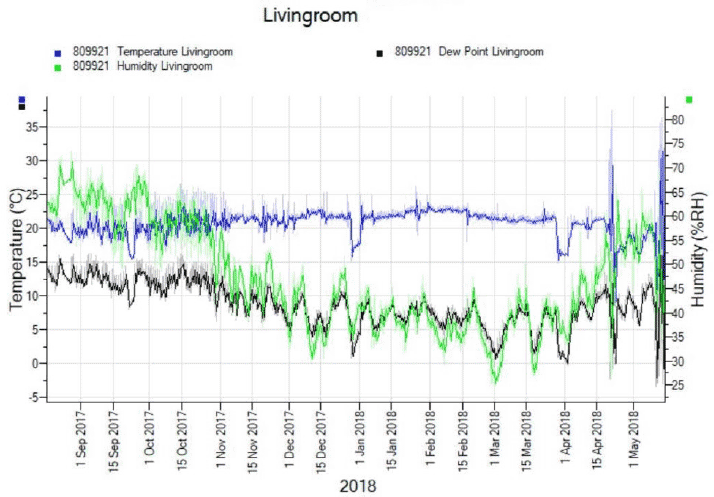
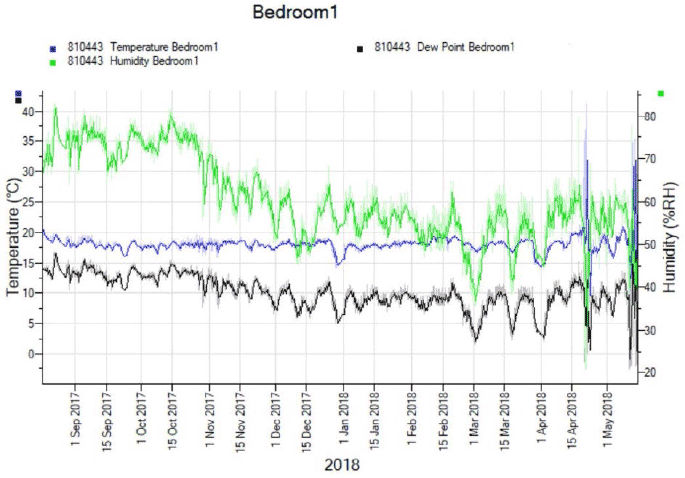
Photos
Photo 1: Plant pot holding guttering together at living-room corner
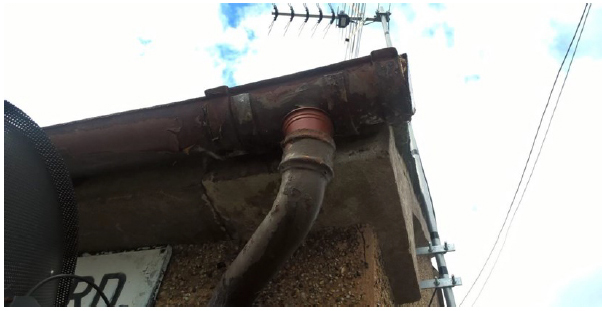
Photo 2: Broken guttering and cracked masonry at bedroom corner
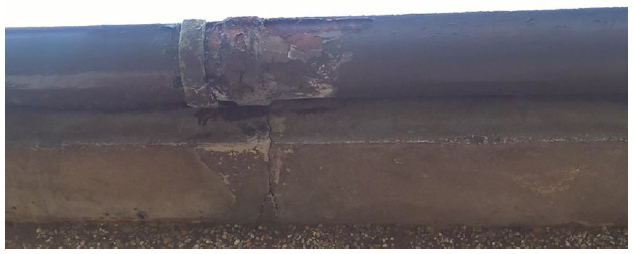
Photo 3: Damp patch in corner of bedroom near broken gutter

Case Study 2
D
Visits: 25/01/2018, 13/02/2018, 26/04/2018
D heard about Home Energy Scotland from a friend. He lives alone and takes medication for a heart condition which means he feels the cold. The home is around a hundred years old and is built of solid brick with no wall insulation. The oil boiler is broken so there is no central heating. D is on a low income but does not qualify for Warmer Homes Scotland.
The home is very cold with just open fires for warmth in the living room and bedroom and no heating to the other four rooms, so D goes to work or out to avoid being cold at home - he told us he is dreading next winter. Tiny Tag temperature and humidity monitors have been in place since 15 February and show the temperature to August in the living room and bedroom averaging 13 degrees Celsius: between 15 February and 15 April the temperature rarely exceeded 10 degrees Celsius. The temperature in the living room did not consistently reach 18 degrees until late June. On a few occasions the lowest temperature in the living room and bedroom was around 2 degrees Celsius (see graph below).
Occupants
- One adult 56.
- Heart condition requiring medication.
- D's father owns the property but does not live there. D is responsible for the upkeep of the property. We are advised by The Moray Council that the property is exempt from Landlord Registration requirements because the tenant is a family member.
- Low income £16,570 /annum, in work. Awarded Universal Credit in July as a result of benefits check.
- Does not qualify for Warmer Homes Scotland.
Property
- Detached house with room in roof, three bedrooms (two of the bedrooms could be partially heated because they are not in use), one living room, kitchen and bathroom.
- Uninsulated solid brick walls.
- Two open fires, one with a back boiler that provides hot water.
- Oil central heating boiler is very old and has been broken for eight years (this was second hand when it was installed to the property and is now obsolete).
- Single glazed windows.
- Doors are poor fitting and draughty. The back door is an internal door not suitable to keep the weather out.
Measures recommended
After discussion, the Energycarer and D agreed that a suitable provision of heat for D's needs would be reliable central heating and controls to heat the main living area - living room, kitchen and bathroom. Four rooms would be partially heated. The aim is to reduce the household energy cost to below £2000 per year while providing a level of heat that is comfortable for D to spend time at home. Switching electricity supplier and tariff could result in a significant saving which would be used toward the cost of heating. Ideally the external doors would be replaced and secondary glazing fitted, however D does not have any savings or income to afford these improvements. Warm curtains would cost less and help to keep the heat in.
Replacing the broken oil boiler with new heating would be vital to providing a comfortable and healthy living environment.
- Assess the existing heating system to see if it can be repaired or requires replacement - priority.
- Assess impact of secondary glazing or thermal curtains potentially funded by HES Homecare.
- Assess impact and cost of new doors potentially funded by HES Homecare.
Advice Given
- Advised on Warmer Homes Scotland eligibility.
- Advised on and referred for benefits check. Awarded Universal Credit as a result in July 2018 - no effect on eligibility for Warmer Homes Scotland. Letter received October 2018 informing that he is now not eligible for Universal Credit.
- Tariff and fuel billing - because the home is connected to other buildings on the farm and has multiple meters and high electricity usage, HES Homecare referred D to local advice agency REAP - Rural Environmental Action Project for fuel billing support.
Continuing support
- Tiny Tags installed to monitor temperature and relative humidity and base follow-up advice on this information (see graph below).
- Support provided by REAP to understand fuel bills and potentially change tariff and supplier.
- HES Homecare assessment for intervention funding to assess oil central heating system. If required, a new system at cost of approximately £7,000 (plus smoke alarms, fees and vat). We do not know if enabling work would be required e.g. a new oil tank - a technical survey will provide guidance.
- Signposted to RSABI (Royal Scottish Agricultural Benevolent Institution) for possible financial grant funding.
Affordable warmth assessment
| Item | Amount | Notes |
|---|---|---|
| Income - before Universal Credit application | £16,570 /annum | |
| Unavoidable living costs | £11,570 | |
| Disposable income | £3,120 | |
| Estimated energy cost using two open coal fires (actual heating). No supplier/tariff switch. This is based on actual cost of coal and electricity last winter. |
£1,927 | No heating in four rooms. |
D is spending around 11% of his income on energy and is not able to be comfortably warm in his home. Our aim is that using an efficient controllable central heating system he could spend around the same amount and benefit from more heat in the rooms he uses most. HES Homecare recommends that D's broken oil central heating is assessed to see if the boiler can be repaired or needs to be replaced with a new boiler or heating system.
Electricity tariff
The Energycarer is going to support D to switch from his current non-domestic rate of 15.74p/kWh to a more affordable domestic rate which could result in a saving of around £210 per year. The standing charge has recently increased to 42.42p from 23.98p meaning savings could be around £280 per year. S will also support D to reduce the electricity consumption.
| Usage / year | Tariff up to 19/07/2018 | Current tariff from 20/07/2018 | Suggested tariff cost |
|---|---|---|---|
| 15.74p/kWh (current) | 15.74p/kWh (current) | 12.5p/kWh (estimate) | |
| 5936kWh (estimate) | £934/annum | £934/annum | £742/annum |
| Standing charge | £87.5 | £154.8 | £70/annum (estimate) |
| Total / year | £1,021.50 | £1088.80 | £812 |
Temperature and relative humidity
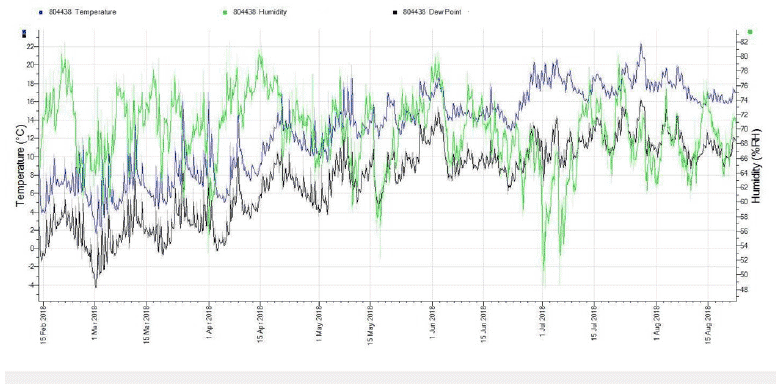
Graph showing temperature, relative humidity and dew point, 15 February to 15 August 2018
Outcomes
HES Homecare asked Scottish Government to review this case with regard to funding a potential boiler replacement or new central heating system as an exceptional case via Warmer Homes Scotland. The decision was that the client does not meet the eligibility criteria and given there are many other households in similar situations Scottish Government would not consider this as an exception. Scottish Government also directed that it would not be supportive of using HES Homecare intervention to fund this. Whilst the client in demonstrably in fuel poverty, he is in employment and the owner of the cottage has an obligation to provide adequate heating provision. The client should be directed to the landlord to address the heating situation and encouraged to get a tenancy agreement in place to protect his rights as a rent payer.
HES Homecare is advised by The Moray Council that the property is exempt from Landlord Registration requirements because the tenant is a family member.
S spoke with D again on 17/10/2018 for an update:
- D contacted RSABI but was not successful with any financial grant.
- D has received a letter from DWP to say he is now not eligible for Universal Credit.
Photo 1: Loft space with some insulation
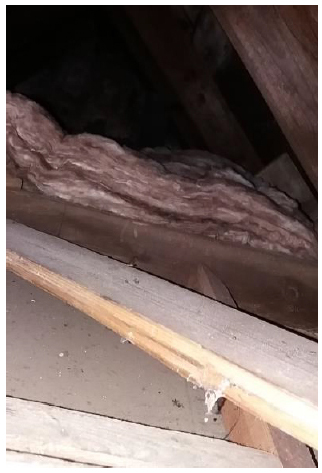
Photo 2: Single glazed window
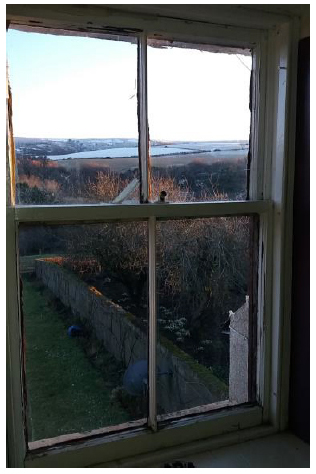
Case Study 3
F & A
10 visits: 15/08/2017, 08/11/2017, 15/11/2017, 29/11/2017, 24/01/2018, 07/02/2018, 20/02/2018, 15/03/2018, 22/03/2018, 16/04/2018.
F lives in a park home in Elgin. F's husband, A, initially made contact with Home Energy Scotland but passed away during the course of the support from HES Homecare. He had called Home Energy Scotland advice centre and a Community Liaison Officer visit was arranged as both were elderly, in poor health and struggled to keep up with conversation over the phone. At that time Elgin was not within the HES Homecare area however the Energycarer was asked to carry out the visit as he was visiting HES Homecare clients in nearby Moray East.
On the visit the Energycarer found the gas combi boiler was old and repeatedly losing pressure leaving the couple without heat or hot water. A had been in contact with an organisation which he thought was The Moray Council to install a boiler on what seemed to be a financial repayment scheme. A was unable to provide any details as he was so confused with whom he had spoken to but suggested it was Moray Council as he had visited the Council offices in Elgin. The Energycarer checked with The Moray Council and confirmed that it does not offer any financial help with replacement heating systems and most likely had advised A to contact Home Energy Scotland. F and A struggled to provide information on energy costs as electricity is paid to the Park owners within the land lease and they were unable to show any gas bills. The main concern was if the boiler broke down there would be no help as the couple are not in receipt of any benefits. The Energycarer made a referral for a benefits check visit from the Department for Work and Pensions to see if that would enable F and A to gain access to Warm Homes Scotland and offered to return at a later date to check on progress.
Occupants
- Owner occupier, land rented from caravan park.
- Two adults aged 82 and 80.
- Both suffered from mobility issues, A had diabetes and died of undiagnosed cancer.
Property
- Park home pre 2005.
- Gas central heating boiler broken beyond repair.
Measures recommended
- Replacement boiler, heating controls and radiators.
Advice Given
- Advised on home heating and expectations of new system.
- Advised on installation process.
- Revisited to advise on heating controls
Continuing support
- Referred for a benefits check home visit from DWP.
- Followed up with a call to DWP to request a self-assessment pack.
- Closely managed install of replacement gas central heating system.
When HES Homecare was extended to include all of The Moray Council area, the Energycarer returned to visit F and A with colleague Diane, a very experienced Community Liaison Officer. As far as they could tell, there had been no benefits check visit in the meantime and the household income was from basic pensions. They organised for a self-assessment pack to be sent by the Department for Work and Pensions to apply for a benefit, but on a later visit, the Energycarer was told this had never arrived.
With the difficulty in communication, the HES Homecare group determined that having made a referral for a benefits check rather than delay we would focus on making sure there was a reliable heating system installed to replace the old boiler through HES Homecare intervention fund rather than Warmer Homes Scotland as no other measures were required and further surveys could confuse the situation.
The installation of the replacement central heating system was postponed from December to 11 January because A was in hospital. When the installer contacted F on 10 January they found that A had passed away over the holiday period. The installer postponed the installation until such time as F was ready to have replacement heating installed. A week later, Home Energy Scotland received a call from F to inform us that A had passed away. The Energycarer visited F again to explain what is happening, and to get her written consent to replace her central heating free of charge, which previously had been in A's name. This is not something that HES Homecare intended to trouble her with, however because it seemed that she was forgetting what had been agreed from one visit to the next, this would be a safeguard in case she did not recall having agreed to accept the offer.
On 24 January, the Energycarer returned to visit F with a Community Liaison Officer after receiving a call from the installer who had tried to visit F to rearrange the boiler replacement. F had not answered the door on that occasion as she was not sure of who the installer was. When the Energycarer visited, F recognised him from previous visits and understood that this was connected to the boiler. On this visit F's friend who also lives on the caravan park came over which allowed the Energycarer to explain the many visits and some paper work which had been discovered when trying to sort through A's accounts. This friend became a valuable asset in making sure the installation could take place. F was happy to sign a new survey agreement as well as confirmation that she was happy for the install to go ahead on 7 February. The Energycarer was present at the caravan site when the installer arrived to ensure the install went as planned and F was able to visit with her neighbour in the park while the work was carried out.
Due to their circumstances - difficulty in communication, and this being a barrier to a benefits check - this household would not have been able to gain access to government assistance without HES Homecare support.
Securing a benefits check has proved to be a problem as two referrals for a DWP home visit have been made however DWP is not able to share the outcome with Home Energy Scotland due to data protection restrictions - it confirmed that appropriate action has been taken. F's income may be above the threshold to receive assistance.
Affordable Warmth
It was not possible to calculate whether affordable warmth has been achieved here as the clients' accounts and details were not available. The main objective of HES Homecare intervention was to ensure a safe and reliable heating system to replace the existing boiler.
It is difficult to determine the energy performance of the home because the DEHRA tool does not have the functionality to assess park homes. Park homes are classed as inefficient within Warmer Homes Scotland qualifying criteria and a new boiler will more efficient and reliable.
This case demonstrates the challenge of supporting extremely vulnerable elderly householders.
- Two-person visits, signed offer letters, and inclusion of a third party contact were used to provide reassurance to F, and to minimise the risk of a dispute over what had been agreed on visits.
- HES Homecare attempted to use the evaluation survey with this household. This was of very limited use and distressing to the householder given that communication was difficult in general.
Case Study 4
S
Visits: 27/11/2017, 07/02/2018, 16/03/2018, 17/05/2018
S attended an event organised by Home Energy Scotland South West to advise people on how to stay warm during the winter. A Private Sector Landlord specialist advisor arranged a joint visit with the Energycarer to see how HES Homecare and the specialist service could work together to advise and support S.
Occupants
- One adult 53.
- In receipt of PIP and ESA.
- Private tenant.
Property
- End terrace with room-in-roof, three bedrooms, living room, bathroom and kitchen.
- Electric panel heaters using standard domestic tariff, open fire.
- Single immersion heater using standard domestic electricity tariff.
- Cavity wall insulation not possible because of severely cracked render on gable end...
- Single glazed windows.
- Doors poorly fitting and draughty.
- Electricity cost of 12.45p/kWh, declined referral to Citrus.
- SAP 12 band G.
Measures recommended
- LPG central heating system and controls.
- Energy efficient doors and glazing.
- Estimated annual saving of £554.
- If measures above were installed SAP 31 band F.
The heating in the house was an open fire and some wall-mounted panel heaters. Both the panel heaters and the single immersion hot water heater were using through a standard domestic single rate electricity meter. The Energycarer referred S to Warmer Homes Scotland and arranged to be present for the survey to support her.
During the survey S was offered energy efficient doors and glazing. The Energycarer questioned why S was not offered a heating upgrade. Warmworks normally do not offer heating upgrades to private sector tenants unless there is no heating 'system' in the property. The Warmworks surveyor contacted their manager and explained that S only had 'secondary' heating in her house. After this call her offer was amended to include a full LPG central heating system and controls for free under Warmer Homes Scotland.
S's landlord was not willing to consent to any heating until they were satisfied that the technical survey specification met their approval. Without the landlord consent, the technical survey cannot be commissioned by Warmworks. Similar to another HES Homecare client case study, HES Homecare arranged with Warmworks for the technical survey to be conducted. with HES Homecare committing to pay for the survey if it did not progress to install.
The landlord rejected the offer of LPG heating on the basis of high running costs for their tenants and stated a preference for oil central heating. New oil central heating is not offered under Warmer Homes Scotland. The Energycarer asked the landlord if they were planning to install oil central heating to benefit the tenant and was told this was out of the question. The Energycarer explained that S's current heating of electric panel heaters and an open fire was much more expensive to heat the home than LPG central heating and that at current prices there is very little difference in running cost between oil and LPG central heating. The landlord still rejected these measures.
The Energycarer consulted with the PSL specialist advisor and informed the landlord that new legislation had been announced for energy efficiency of properties with the privately rented sector. It states:
- All privately rented properties must reach a minimum rating of band E if a new tenant moves into a property after the 1st of April 2020.
- If the same tenant continues to live in a property from before the 1st of April 2020 then the property must be a band E by 1st of April 2022.
S's home has EPC 12 Band G so the landlord has a limited time to increase the SAP rating before they are no longer legally able to rent the property. The measures offered under Warmer Homes Scotland would increase the EPC rating of the property to SAP 31 band F, 6 points away from the new legal minimum. This finally convinced the landlord and they approved the measures.
The Energycarer assisted S to choose an LPG supplier and arranged for Calor Gas to come out and survey for an LPG tank. The Energycarer attended the survey and was told that the only way a tank could be fitted into the garden was if it was submerged and a one metre fire wall built between S's garden and her neighbour. Calor Gas charge £1,500 to submerge the tank but are unable to facilitate building a fire wall. The Energycarer contacted the landlord to inform them of this cost and they rejected contributing to the cost of the tank. The Energycarer again discussed the cost benefit to S of the new heating being installed and explained that for this relatively low cost, they are receiving a huge improvement to their property. Unfortunately the landlord rejected the measures and so S's Warmer Homes Scotland journey was cancelled.
Affordable Warmth
S is not sure what her income is but estimates it to be in the region of £12,000. Estimated cost to heat home to standard heating pattern £2,669 per annum which is to 22% of total household income. S is in fuel poverty. If the measures offered under Warmer Homes Scotland were installed S could expect to spend £2,115 a year on energy which is 17.6% of her total income. S would still be in fuel poverty but would have reduced her fuel bills by over 20%.
Outcomes
- Attempted negotiation with landlord failed after initial success.
- Warmer Homes Scotland journey cancelled.
- No improvements were installed.
- S is still in fuel poverty, spending 22% of her income on fuel.
Case Study 5
L
Visits: 30/08/2018, 21/9/2018
L was referred to HES Homecare by Moray Care and Repair because her roof needs some repairs and there is damp in the upstairs bedroom. L has a very low income and is receiving treatment for cancer. The Energycarer advised to do a benefits check but L declined because she had a negative experience which left her in dire straits when she had to repay over-paid benefit after pointing out to DWP that she should not be receiving the funds. L is not fit enough to work full time and has a part time job earning around £300 a month. She has released her pension early to try to make ends meet.
Occupants
- Owner occupier.
- One adult aged 60 (not pensionable age).
- Receiving treatment for cancer.
- Low income £3,600 from part time job plus £6000 released from pension.
- Does not qualify for Warmer Homes Scotland because she is not in receipt of a qualifying benefit.
Property
- Mid terraced house with room-in-roof, two bedrooms, one living room, kitchen and bathroom.
- Gas central heating.
- SAP 42 band E.
- Windows double glazed uPVC other than one Velux that is wooden framed.
- Kitchen window latch/mechanism is broken, window held shut with a plank of wood (see photos below).
- Uninsulated solid stone walls with brick kitchen and bathroom extension.
- Damp on walls of the front of the property (stone part of the property), this may be from leaking gutters that have been fixed or from the door plate not stopping sitting water seeping in to the hall.
- Damp on the slope of the upstairs bedroom which could be from the damage to the roof.
- Doors are poorly fitting, rotten and draughty. The back door is an internal door not suitable to keep the weather out.
Advice Given
- Advised on Warmer Homes Scotland eligibility.
- Advised on benefits check.
- L pays for energy using prepayment meters which she easier to budget and is happy with her electricity and gas supplier,
Measures recommended
- Repair or replace kitchen window.
- Repairs to roof to prevent further water leak.
- Ideally the external doors and frames would be replaced however L does not have any savings or sufficient income to afford these improvements.
Affordable warmth assessment
L is spending around 10% of her £9,600 annual income on her energy bills and is not comfortably warm in her home: she said she only puts the heating on for the minimum time and wraps up to keep the bills down. If she were to heat the home adequately the projected cost would be £1147 which is 12% of her total income and 42% of her disposable income after unavoidable living costs. She is in fuel poverty.
| Item | Amount | Notes |
|---|---|---|
| Income / annum | £9600 | |
| Unavoidable living costs | £6900 | |
| Disposable income | £2700 | |
| Estimated energy cost from payments made | £960 | Suggests the home is under-heated |
| Projected cost to heat the home to standard heating pattern (from DEHRA) | £1147 |
Tinytag temperature and relative humidity monitors were installed 21/09/2018.
Continuing support
- Application for Warm Homes Discount submitted. L is eligible without benefits through her supplier.
- Monitor temperature and humidity
- Explore cost of repairs through Care and Repair.
Care and Repair has offered a housing repair grant of 75% of the cost of the repairs to roof, window and doors. At the Advisory Group meeting in September 2018 Care and Repair asked for clarification as to whether HES Homecare intervention fund could be used to provide the remaining 25% of the funding required. There was no objection from the advisory group.
HES Homecare sought advice from Care and Repair Scotland and from Scotland's Housing Network who responded:
"If I understand correctly, you want to combine two grant sources to cover the full costs of repairs in this case. On[e] of these is the local authority's housing repair grant and the other is from a fuel pover[t]y fund, also administered by the local authority. I have spoken to colleagues in fuel poverty policy and their view is that the use of the fuel poverty fund is at the discretion of the fund holder. As far as the repair grant is concerned, ultimately this is discretionary fundings (sic) from the capital grant to the local authority. In both cases, this is at the discretion of the local authority, so provided the use complies with local priorities, we would not see any objection to using the funding in the way proposed."
Based on this advice, HES Homecare intends to offer to fund 25% of the cost of repairs to L's home carried out through Care and Repair to address the disrepair and prevent further dampness and heat loss. We are awaiting quotes for this.
Photo 1: Rotten door frame
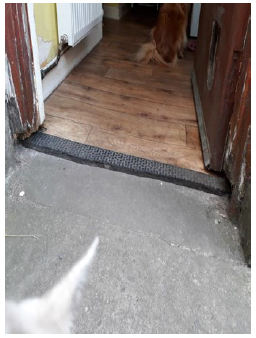
Photo 2: interior door used for exterior door
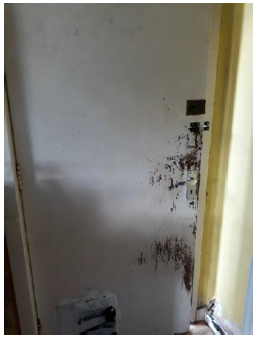
Photo 3: Damp on upstairs bedroom
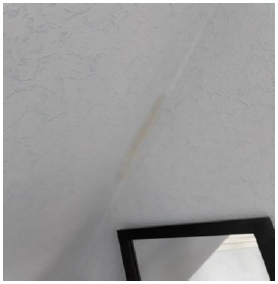
Photo 4: Damaged kitchen window ceiling
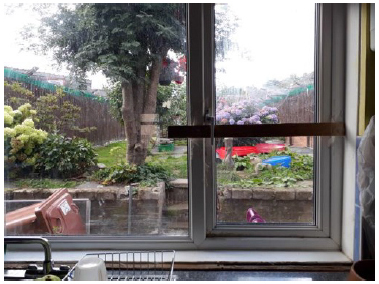
Photo 5: Damp on the hall wall
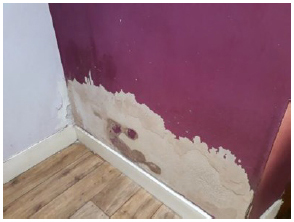
Photo 6: Damp on the hall wall
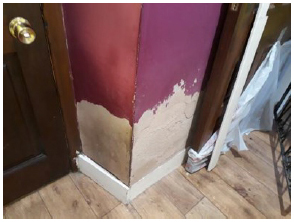
Case Study 6
T & I
Initial visit date: 04/07/2017, second visit: 29/08/2017
T met a Home Energy Scotland Community Liaison Officer at an outreach event at the Ecclefechan Day Centre. T has chronic obstructive pulmonary disease and her husband I has mobility issues. T had recently had a benefits check and was not eligible for Warmer Homes Scotland but was finding the home cold.
The Energycarer visited the couple and found that there is an extension to the rear of property that contains the bathroom and the kitchen. The extension has a flat roof and the walls are either a very narrow, unfilled cavity or solid brick. Neither room had fixed ventilation and mould was widespread in both rooms indicating condensation dampness. The join between the pitched roof and the wall of the extension appeared to be wet as there was green algae growth which may indicate a leak (see photo 2 below).
The Energycarer visited again to complete the evaluation Survey 1 and install Tiny Tag temperature and humidity monitors to help investigate the cause of the dampness. The Energycarer referred T and I to Care and Repair to arrange a contractor for dampness investigation. The contractor found that there was no water leak from outside and confirmed the Energycarer's assessment that the dampness in the extension was condensation due to lack of ventilation and insulation and was commissioned to insulate the ceiling and install humidistat extractor fans to each room. Work was completed in December 2017.
Unfortunately since then T passed away. The Energycarer attempted to make contact with I several times and wrote to I urging him to get back in touch if he wishes to have further support. Tiny Tag devices have not been collected and Survey 2 was not completed.
Occupants
- Owner occupier.
- 2 adults aged 79 and 85.
- Chronic obstructive pulmonary disease (COPD), mobility issues.
- Personal circumstances (benefits) do not meet Warmer Homes Scotland criteria.
Property
- Semi-detached, 1 storey, 1 bedroom, 1 living room, 1 toilet and 1 kitchen.
- Solid stone walls. Later extension to rear - unclear if solid brick or a very narrow cavity, it measures around 300mm thick.
- Condensation dampness in extension - kitchen and bathroom: mould photographed.
- Insufficient ventilation to kitchen and bathroom - small trickle vent in window, no extractor fans. Cooker hood is unvented.
- Energy rating SAP 62 - meets criteria for Warmer Homes Scotland despite recent boiler replacement.
Measures recommended
- Flat roof insulation to extension.
- Ventilation to bathroom and kitchen - humidistat extractor fans.
- Cavity fill or internal wall insulation to extension once dampness issue is resolved (subject to survey).
Advice given
- Advised on heating controls for new boiler.
- Advised at time of visit that at this stage we are unsure of what measures can be offered as part of HES Homecare.
- Advice to address condensation - ventilation, heat, minimise steam.
- Tiny Tags installed to monitor temperature and humidity in kitchen compared to living room and bedroom.
- Recently entered a 12 months fixed term electricity tariff, so Citrus Energy support was not offered.
Outcomes
- Measures put in place to solve dampness issues - humidistat extractor fans.
- Flat roof insulation estimated to save £53 per annum.
Affordable Warmth
In September 2017 T and I had a joint income of £300-400 per week or £15,600-20,800 per annum. The energy cost to heat the home to the standard heating pattern was estimated at £1,094 which is 5.2-7.0% of the household income. The household was not in fuel poverty.
As a person-centred service HES Homecare made the decision that because of T's respiratory condition the health benefits of removing the mould and addressing the cause of the mould justified use of the HES Homecare intervention fund. The household had very limited savings and the improvements would not otherwise be made. Intervention fund was used to install humidistat extractor fans and ceiling insulation to the kitchen and bathroom.
Tiny Tags temperature and humidity monitoring
Tiny Tag monitors were installed to monitor the temperature and relative humidity in the home however it has not been possible to retrieve them as I has not responded to attempts to contact him by phone and letter.
Photos
Photo 1: Mould on kitchen ceiling under flat roof
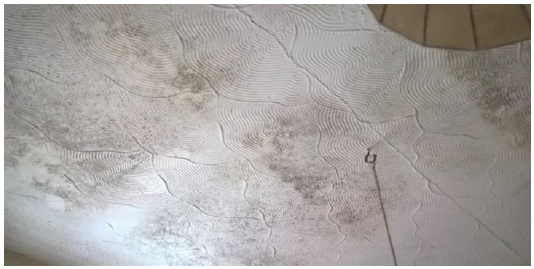
Photo 2: Flat roof to extension, join of pitched roof to extension (kitchen door)
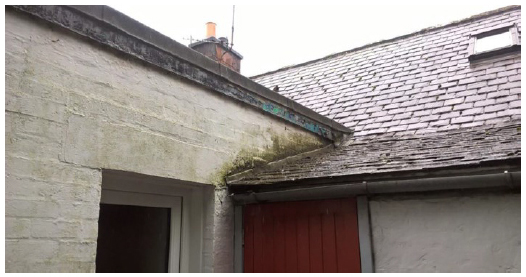
Photo 3: Extension wall construction showing thickness of wall. Condensation is visible on inside of kitchen window.
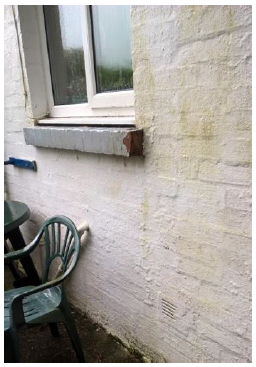
Contact
Email: Fuel_Poverty_Team@gov.scot
There is a problem
Thanks for your feedback